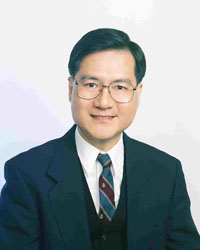江簡富 Jean-Fu Kiang

Jean-Fu Kiang ( 江簡富 ) received the BS degree in Electrical Engineering from National Taiwan University in 1979 and the Ph.D. degree in Electrical Engineering from Massachusetts Institute of Technology in 1989. He has been a professor of the Department of Electrical Engineering and the Graduate Institute of Communication Engineering, National Taiwan University since 1999.
He has been guiding his students to apply different ideas, theories and methods in exploration of various electromagnetic phenomena and possible applications. Recent endeavors include how to merge multiple modes in a dielectric resonator antenna to increase its bandwidth (2007- 2009); how a tsunami wave perturbs the ionosphere and affects the GPS signals, leading to a method to detect a tsunami within 15 minutes of occurrence (2009); how to design 3D miniaturized broadband antennas with size of λ/10 (2010, 2011); how to improve the accuracy of a differential GPS system to within a few cm at a distance of 100 km from the reference station, leading to one possible application to measure the real-time wind field within a typhoon (2011); how to optimize a large phased array with tens of thousands of antenna elements by using evolutionary algorithms (2013-2015); how to reconstruct a better image of a celestial object 60 million light-years from the Earth, based on very-long baseline interferometry (2014); how to design super-lenses with meta-materials to achieve a resolution of λ/30 (2014); how to simulate wave propagation in the lower atmosphere, considering the effects of refractivity profile inversion and turbulence, under different weather conditions (2014); how to model the synchronization among an array of coupled oscillators originally operating at different frequencies (2014, 2015); how to reconstruct high-fidelity microwave images of multiple underground objects (2014, 2015); how to simulate wave scattering by a very large rough surface (2015); how to compensate for the coupling among antennas in an array to improve the direction-of-arrival estimation to within 0.1 degree, even from directions far away from normal incidence (2015); how to evaluate the impact on ground objects from a high-altitude electromagnetic pulse (2016); how to estimate the parameters of an evolving sand-and-dust storm using improved radar equations (2016); how to apply LEO-ground infrared laser occultation technique and a harmony search algorithm to retrieve major greenhouse gas profiles around a specific receiver site in nearly real time (2017); how to apply synthetic- aperture radar (SAR) imaging on ground objects at high squint angles (2017); how to compensate motion errors in SAR imaging (2017); how to apply microwave hyperthermia to treat cancers (2018, 2019); how to process radar signals to estimate direction-of-arrival (DOA) and carrier frequency of multiple signal sources with co-primed array and triply-primed array techniques (2018, 2019); how to compute the brightness temperatures from very lossy medium by using finite-difference time-domain (FDTD) method to obtain near-field bistatic transmission coefficients and by extending the Planck's law to lossy medium (2019).
Documents of these works and other interesting explorations can be viewed at the website: